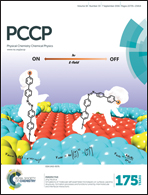Gas phase ultraviolet and infrared spectroscopy on a partial peptide of β2-adrenoceptor SIVSF-NH2 by a laser desorption supersonic jet technique
Abstract
Laser desorption supersonic jet laser spectroscopy has been applied to a penta-peptide, Ser-Ile-Val-Ser-Phe-NH2 (SIVSF-NH2), which is a partial sequence of a binding site in a β2-adrenaline receptor protein. By comparing the resonance enhanced multiphoton ionization spectrum with the ultraviolet−ultraviolet hole burning (HB) spectrum, it is concluded that only a single conformer exists. The infrared (IR) spectrum of the X–H stretching region, measured by IR dip spectroscopy, shows that all of the OH and NH groups form hydrogen bonds. The structure of SIVSF-NH2 is assigned by the combination of a force field calculation (CONFLEX) and quantum chemical calculations both in S0 and S1. Over 20 000 stable conformations, given by CONFLEX, are classified into 6987 groups and 1068 groups in which all of the NH and OH bonds are hydrogen-bonded are selected. The most stable structure in each group was geometrically optimized by density functional theory (DFT) calculations, and theoretical IR spectra were calculated for the conformers for which the energies are within 10 kJ mol−1 of the most stable one. It has been found that the most stable and the secondmost stable conformers well-reproduce the observed IR spectrum. The vibrational frequencies in S1 were also calculated for these two conformers. According to the reproduction of the vibrational frequencies in the HB spectrum, the structure of SIVSF-NH2 is assigned to the most stable conformer, which forms a hydrogen-bonded structure corresponding to a compact, distorted version of the beta hairpin of peptides and proteins.


 Please wait while we load your content...
Please wait while we load your content...